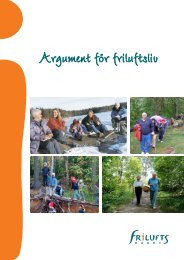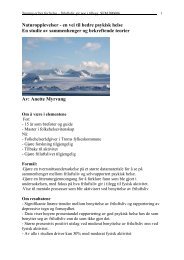Green Care: A Conceptual Framework - Frisk i naturen
Green Care: A Conceptual Framework - Frisk i naturen
Green Care: A Conceptual Framework - Frisk i naturen
Create successful ePaper yourself
Turn your PDF publications into a flip-book with our unique Google optimized e-Paper software.
as interventions/therapies. <strong>Care</strong> farming, because of its broad range of<br />
approaches and activities, extends in the model from health promotion,<br />
through therapy, to work rehabilitation/ sheltered green employment (the<br />
bottom layer). In reality, the boundaries between layers, activities and the<br />
sub-categories are not always distinct. However, by classifying them in this<br />
way it is hoped that the reader will get a better idea of the complexity of<br />
green care and how different approaches and interventions are connected.<br />
3.3 The essentials of green care: ‘common’ and<br />
‘natural’ dimensions<br />
<strong>Green</strong> care interventions, for example, care farming and therapeutic<br />
horticulture enable clients to participate in activities that are meaningful<br />
and productive and that have many attributes in common with paid<br />
employment. These include physical activity, daily routine, social<br />
interaction and opportunities and so on. It could be argued that many forms<br />
of sheltered employment in factories or workshops would provide the same<br />
benefits as green care, albeit in a different environment. Sempik et al (2005)<br />
have shown that social and therapeutic horticulture (STH) enables clients<br />
to be productive in an environment that is not pressured; to develop a sense<br />
of identity and competence around ‘being a gardener’ or a ‘worker’ rather<br />
than a patient; it enables them to engage in social interaction; to develop<br />
daily routine and structure; to participate in the running of their project;<br />
sometimes to be paid for their work or on occasions to be helped to find<br />
paid employment. All of these aspects can be supplied by approaches and<br />
interventions that do not use a natural setting. Indeed, Sempik et al (2005)<br />
reported that the managers of one STH project were ambivalent to the<br />
natural dimension and suggested that their clients would have been just as<br />
happy and motivated manufacturing “double glazing units”. The clients<br />
were very firmly of the opposite opinion. They clearly valued nature and<br />
considered it to be a powerful influence on their health and well-being.<br />
Such a view of nature is present throughout the literature. Indeed, there is<br />
evidence of the psychological benefit of the natural environment in aiding<br />
recovery from stress (see Section 6.4) or restoring the ability to focus<br />
attention (see Section 6.3).<br />
Activities and processes within green care can be categorised as those that<br />
are ‘common’, i.e. that occur in common with other circumstances and<br />
approaches and do not necessarily involve or require a natural environment.<br />
30 <strong>Green</strong> <strong>Care</strong>: A <strong>Conceptual</strong> <strong>Framework</strong>















